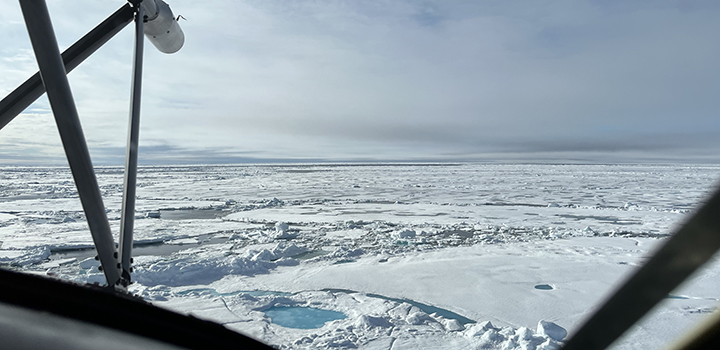Arctic flights to shed light on sea ice and storms link
By: News archive

Scientists from the University of East Anglia are spending the summer flying research aircraft through the heart of Arctic storms to better understand how weather systems are affecting polar sea ice.
They are part of an international team flying two aircraft on around 60 missions during the course of a month from the Norwegian Arctic, to study Arctic summer cyclones for the first time.
Arctic cyclones are the main type of hazardous weather that affect the polar environment during summer. They can impact sea ice movement and trigger rapid ice loss, effects which themselves influence the development of cyclones.
The project will create the most detailed physical picture yet of how the ice and ocean interact with the atmosphere above, in order to better simulate this in weather and climate prediction models.
Prof Ian Renfrew, from UEA’s School of Environmental Sciences, said: “From our base in Svalbard, we will be investigating summertime Arctic Cyclones and how these weather systems interact with the sea ice.
“Recent decades have seen a dramatic fall in Arctic sea ice area and cyclones appear to both slow down and speed up the ice decline, depending on the time of the year. The physical processes are unclear and one of our aims is to investigate the affect of the cyclones on the sea ice and the affect of the sea ice distribution on the cyclones.”
As a result of global warming, sea ice is becoming thinner across large areas of the Arctic Ocean in summer, year on year.
This means that winds can move the ice more easily, which in turn can influence weather systems. This makes predicting changes to the Arctic environment difficult in both the short and long term.
The dramatic changes in Arctic ice are expected to become increasingly important for global climate, making it an urgent problem for study.
Prof John Methven, an atmospheric dynamics researcher at the University of Reading and project lead, said: “Arctic cyclones are understood far less than those in temperate regions, making them even harder to predict.
“This project will examine Arctic summertime cyclones from above, below and right in their midst. It will shed light on the relationship between sea ice and the atmosphere above, which will provide invaluable data to improve understanding of how climate change is affecting this globally important region.”
Temperatures in the Arctic are rising faster than anywhere else on Earth. Climate change has changed sea ice dramatically, making ice thinner and breaking it up, making it more susceptible to winds and storms.
Arctic summertime cyclones can measure thousands of kilometres in diameter and can persist for several days or weeks, often moving south outside the Arctic circle.
The flights, which started on July 27, will run until August 24. A forecast for strong northerly winds during the first week, temporarily slowing sea ice retreat due to recent heat waves in the region, have provided ideal conditions for the first flights.
A team of UK scientists are flying in the British Antarctic Survey Twin Otter plane based from Longyearbyen in Svalbard, the most northerly town on Earth. The Natural Environment Research Council is funding the project team from the University of Reading, University of East Anglia, British Antarctic Survey, National Centre for Atmospheric Science (NCAS) and the Centre for Polar Observation and Modelling.
These low-level flights are taking place over the ocean and sea ice, and particularly over areas where sea ice is breaking up. They are simultaneously monitoring turbulence, heat and moisture in the lower atmosphere and taking detailed measurements of physical properties of the sea ice such as surface height, roughness and temperature.
Scientists from France and the USA are conducting additional flights in the SAFIRE ATR42 plane, which is equipped with radar and infrared sensors. These will take 3D measurements of the movement of clouds and the droplets within them from above during cyclone conditions.
The second team is funded by the Office of Naval Research (United States) and the French National Centre for Scientific Research and National Centre for space Studies (France). It comprises scientists from the Laboratoire de Météorologie Dynamique (LMD), Laboratoire Atmosphères, Observations Spatiales, University of Oklahoma and Naval Research Laboratory, Monterey.
Related Articles

Ultra low frequency gravitational waves detected in space
Researchers at the University of East Anglia are part of an international team that have found evidence for ultra-low-frequency gravitational waves in space.
Read more
Study of Earth's stratosphere reduces uncertainty in future climate change
New research led by the University of East Anglia (UEA) reduces uncertainty in future climate change linked to the stratosphere, with important implications for life on Earth.
Read more
Investigating the coolest climate gas youve never heard of
Researchers at the University of East Anglia have launched a new project to investigate how a climate-cooling gas is produced in agriculture.
Read more